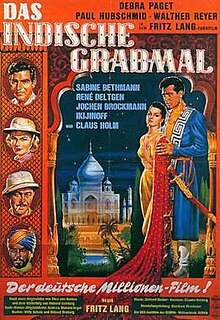The Indian Tomb (German: Das indische Grabmal) is a 1959 adventure film, co-written and directed by Fritz Lang. Produced by Artur Brauner, it is an international co-production of West Germany, France and Italy. It is the second film, after The Tiger of Eschnapur (1959), that comprise "Fritz Lang's Indian Epic" duology, which are based on the 1918 novel Das indische Grabmal, written by Lang's ex-wife Thea von Harbou.
| The Indian Tomb | |
|---|---|
 German theatrical release poster | |
| Directed by | Fritz Lang |
| Screenplay by | Thea von Harbou Fritz Lang Werner Jörg Lüddecke |
| Based on | Das indische Grabmal by Thea von Harbou |
| Produced by | Artur Brauner |
| Starring | Debra Paget Paul Hubschmid Walter Reyer Claus Holm Valéry Inkijinoff Sabine Bethmann |
| Cinematography | Richard Angst |
| Edited by | Walter Wischniewsky |
| Music by | Gerhard Becker Michel Michelet |
Production companies | |
Release date |
|
Running time | 102 minutes |
| Countries | West Germany France Italy[1][2][3] |
| Language | German |
The Indian Tomb stars Debra Paget, Paul Hubschmid, Walter Reyer, Claus Holm, Valéry Inkijinoff, and Sabine Bethmann. Interiors were shot at the Spandau Studios in West Berlin with sets designed by the art directors Helmut Nentwig and Willy Schatz.
In 1960 American International Pictures obtained the rights to both films in "Fritz Lang's Indian Epic", combining them into one heavily edited, 90-minute-long feature named Journey to the Lost City which earned domestic gross of $500,000.[4] After both were dubbed into Spanish, they were shown as separate films, when in fact the second was a direct continuation of the first.
Reception
editOn the review aggregator website Rotten Tomatoes, the film had an approval rating of 88% based on 8 reviews.[5] Contemporaneously Die Welt wrote: "Here lies Fritz Lang, once creator of important films like Metropolis and M. The 'Indian tomb' is his own." [i.e., grave as a filmmaker][6] In contrast to those earlier opinions, contemporary American film critics are positive about the film.[5] The film is probably best remembered today for Debra Paget's sexy "snake dance scene". Hollywood Reporter headlined their review with a publicity shot of her dance, writing, "The pasted-on costume she wears for a long “snake dance” scene, which leaves her nearly naked, seems to do the trick — though Seetha's wardrobe will hardly distract 21st century viewers from perhaps the fakest-looking writhing cobra in movie history."[7]
See also
edit- The Indian Tomb (1921 film)
- The Indian Tomb (1938 film)
Notes
edit- ^ Mannikka, Eleanor. "The Indian Tomb". Allmovie. Rovi Corporation. Retrieved February 18, 2013.
- ^ "Das indische Grabmal". BFI Film & Television Database. London: British Film Institute. Archived from the original on February 7, 2009. Retrieved February 18, 2013.
- ^ "Das indische Grabmal". Filmportal.de. Retrieved February 18, 2013.
- ^ "How foreign product scored in US". Variety. 26 April 1961. p. 170.
- ^ a b "The Indian Tomb (1959)". Rotten Tomatoes. Fandango Media. Retrieved January 28, 2022.
- ^ Der deutsche Film der fünfziger Jahre, Heyne Filmbibliothek, 1987, page 170.
- ^ DeFore, John (2019-09-26). "'The Indian Tomb': Film Review". The Hollywood Reporter. Retrieved 2024-08-01.
External links
edit- The Indian Tomb at IMDb
- A Clip on YouTube from The Indian Tomb (Debra Paget dancing with a cobra)
- "Three and a half Tombs" - article about the genesis of the book and the films made from it
- "Come On, Baby, Be My Tiger" - article about the several versions of the film
- Artur-Brauner-Archive at the Deutsches Filmmuseum in Frankfurt (German), containing the production files for this movie